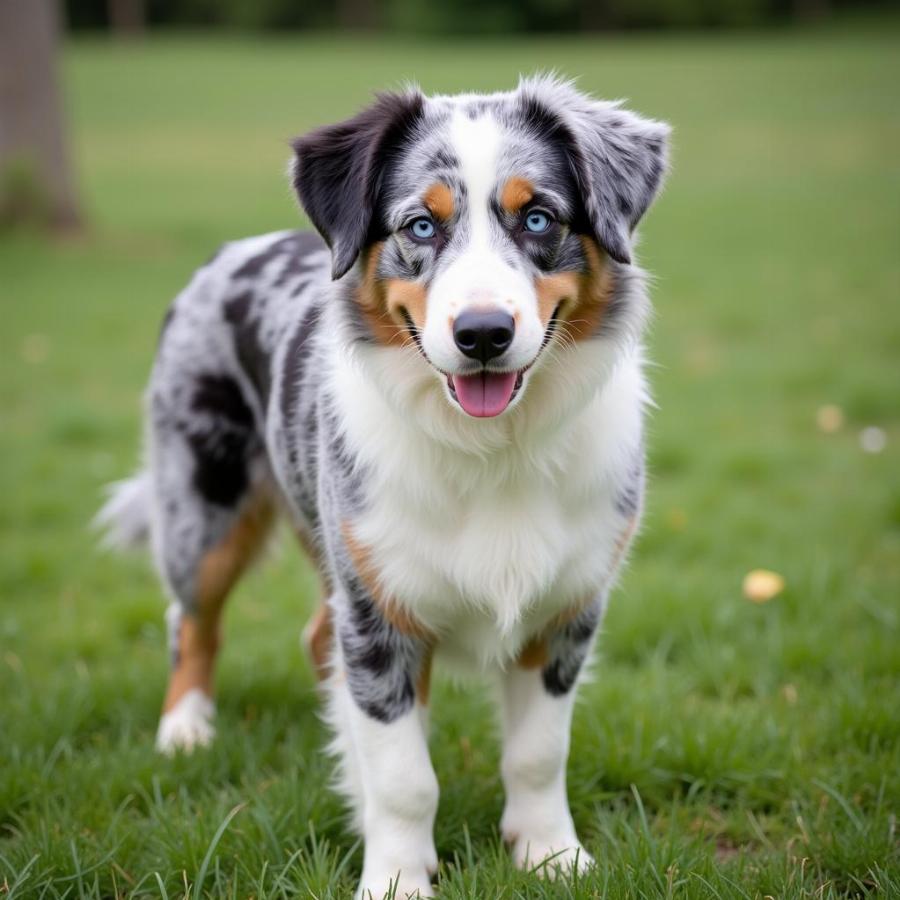The mesmerizing gaze of a blue-eyed dog can capture anyone’s heart. But which dog breeds with blue eyes are out there? From the striking Siberian Husky to the charming Australian Shepherd, several breeds are known for this unique and beautiful trait. This comprehensive guide will explore these captivating canines, delving into their breed specifics, personality traits, and care requirements. Whether you’re already smitten with a blue-eyed beauty or simply curious about these stunning dogs, this article will provide valuable insights into the world of dog breeds with blue eyes.
Decoding the Blue-Eyed Mystery: Genetics and Variations
What causes those captivating blue eyes? It’s often a combination of genetics and sometimes, coat color. Certain genes dilute pigment, leading to lighter eye colors. For example, the merle gene, responsible for the mottled coat patterns in breeds like the Australian Shepherd and Border Collie, can also cause blue eyes. In Huskies, a separate gene entirely can contribute to their striking blue or even bi-eyed (two different colored eyes) appearance. Understanding the genetic factors behind blue eyes helps us appreciate the unique beauty of these dogs.
Popular Dog Breeds Sporting Blue Eyes
Several breeds are known for their blue-eyed members. While not every dog within these breeds will have blue eyes, it’s a prevalent and sought-after trait. Let’s explore some of the most popular blue-eyed dog breeds:
- Siberian Husky: Known for their wolf-like appearance and striking blue eyes, Huskies are energetic and intelligent dogs.
- Australian Shepherd: These intelligent and versatile herding dogs often sport mesmerizing blue eyes, sometimes even in different shades or combined with other colors in the same eye.
- Border Collie: Another herding breed, Border Collies are incredibly intelligent and active. Blue eyes are a common and beautiful feature.
- Dalmatian: While not all Dalmatians have blue eyes, it’s a possibility within the breed, adding to their already distinctive spotted coat.
These are just a few examples, and other breeds, like the Weimaraner and Cardigan Welsh Corgi, can also have blue eyes, though less frequently. You might be interested in learning about the blue merle border collie dog if you’re fascinated by this specific variation.
 Australian Shepherd Blue Merle with Blue Eyes
Australian Shepherd Blue Merle with Blue Eyes
Caring for Your Blue-Eyed Companion
Whether you have a dog blue eyes breed or any other breed, proper care is crucial. While blue eyes themselves don’t require any special care, some breeds prone to blue eyes, like Huskies, have specific grooming needs due to their thick double coats. Regular brushing and occasional baths are essential.
“Blue-eyed dogs, especially those with lighter colored coats, can be more sensitive to sunlight,” says Dr. Amelia Shepherd, a renowned veterinary ophthalmologist. “It’s important to provide them with adequate shade, especially during peak sun hours, to prevent any potential eye discomfort.”
What Dog Breeds Have Blue Eyes?
A number of breeds are known to carry the genes for blue eyes, including Siberian Huskies, Australian Shepherds, and Border Collies. The occurrence of blue eyes can sometimes be linked to the merle gene, which also affects coat color.
Are Blue Eyes in Dogs a Sign of Health Problems?
While blue eyes are generally harmless, in certain breeds and specific genetic combinations, they can sometimes be associated with an increased risk of certain health issues, such as deafness or eye problems. It’s important to research the specific breed and choose a reputable breeder who screens for these potential problems.
“Reputable breeders prioritize the health and well-being of their dogs,” adds Dr. Shepherd. “They conduct thorough health checks and screenings to minimize the risk of genetic health issues.” If you’re considering a big gray dog with blue eyes, remember that responsible breeding practices are crucial for ensuring a healthy companion.
Conclusion
Dog breeds with blue eyes possess an undeniable allure. From the energetic Siberian Husky to the intelligent Border Collie, these dogs captivate us with their striking gaze. Understanding the genetics behind their eye color and the specific needs of each breed allows us to appreciate and care for these beautiful companions. Whether you’re drawn to a specific breed or simply admire the beauty of blue eyes, this guide provides valuable insights into the world of these captivating canines.
FAQs
- Are all Huskies born with blue eyes? No, some Huskies can have brown or bi-colored eyes.
- Do blue eyes affect a dog’s vision? Generally, blue eyes don’t impact vision, but certain genetic combinations can sometimes increase the risk of eye problems.
- What is the merle gene? The merle gene is responsible for mottled coat patterns and can also cause blue eyes in some breeds.
- Are blue-eyed dogs more sensitive to sunlight? Some blue-eyed dogs, especially those with lighter coats, might be more sensitive to sunlight.
- Where can I find a reputable breeder? Breed-specific rescue organizations and reputable breeders who prioritize health testing are good places to start. If you are curious about mixed breeds, check out resources like catahoula leopard dog husky mix for more information.
Other Questions You Might Ask
- How can I train a blue-eyed dog?
- What are the common health issues in breeds with blue eyes?
- What is the best food for a blue-eyed dog?
- Why do some dogs have a glare in their eyes in photographs? Learn more about why do dogs have glare in their eyes on camera.
Beaut Dogs is your go-to resource for all things dog-related, offering expert advice and information on various breeds, care tips, and much more. When you need support, email us at [email protected] for detailed and accurate answers. Visit Beaut Dogs today!